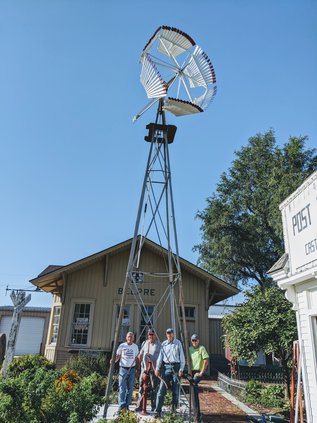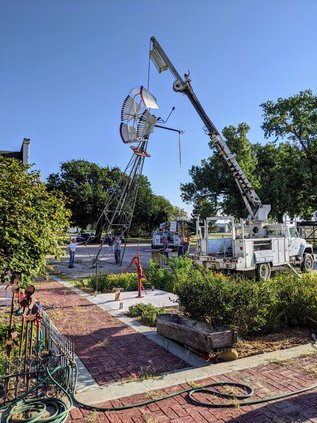A straight-line wind event on July 31, 2019, left the antique windmill at the Barton County Historical Society Village and Museum severely damaged. Steel arms were mangled, and slats on each of the panels were broken off. Already showing signs of weathering and wear and tear before the storm, the wrecked windmill stood battered and beaten.
Like most obsolete machinery, finding parts and qualified individuals who could make repairs was a daunting task. Members of the Building and Grounds Committee, headed by Larry Gale, quickly determined if the windmill was going to be repaired, it would be up to them.
“We are the old-timers now,” Gale said. “There just wasn’t anybody around that could do the work.”
Gale offered his woodworking and mechanical workshop others on the committee, Vernon Hayes, Carl Helm and Larry Klusener, and Randy Suchy agreed to help. Additional help was donated by Randy VonFeldt with metalworking and Chris Warren with painting, and Heartland Collision provided professional painting services and Amerine Utilities provided support as well.
A jackhammer was employed to break the scaffolding from its base by the little post office building. Guide ropes were secured, and the entire unit was dragged into the village driveway, and then it was carefully lowered to the ground. The wheel was separated from the scaffolding, which was then dragged to the side of the depot building. Then a mechanical lift was employed to carefully place the heavy wheel on a trailer. That was on March 18.
The windmill itself was built around the turn of the last century, best guess. Leon McKinney, a Great Bend farmer, restored it originally and donated it to the village in 1975. Since then, it has weathered many storms before the July 2019 storm. Since then, weather has the elements have played their part to age the once ubiquitous machine.
According to research by BCHS codirector Karen Neuforth, Waupun windmills were manufactured by the Aulthouse-Wheeler manufacturing Co. of Waupun, Wisconsin. It is among the many vaneless models, a design developed in the 1880s. Rather than a flat wheel with a weather vane to point it in the direction of the wind, these vaneless models featured a sectional wheel held together by hinges. These hinges allow the sails to collapse inward as the centrifugal force of the wind changes. This causes the self-regulating wheel to move so that it always operates downwind. Waupun windmills were sold by the Great Bend Implement Company owned by Fred Zutavern in the early 1900s.
“There weren’t very many around these parts, but it’s a fascinating system,” Neuforth said. The museum has literature available that describes the workings.
Gale and his team worked to straighten the arms of the wheel, and with some help from Ron Vanfeldt and Chris Warren, overhauled every moving part over the next couple months. Heartland Collision painted select parts of the mechanism. They fashioned new wooden slats using the older unbroken slats as a pattern, painting them the bright white with red tips the original had sported. Each sail of the wheel was rebuilt and reglued with the intention of it lasting several decades into the future, Gale said.
While the work wasn’t exactly light, many hands made for an enjoyable experience. It gave the men a project to occupy their time during the statewide shutdown that resulted from attempts to slow the spread of COVID-19.
“It was our pandemic project,” Gale said.
By June 11, all of the work that could be completed in the workshop was done. The men brought the disassembled wheel back to the village and reassembled it on-site, piece by piece, with supports provided by Amerine Utilities. Then the team reattached it to the scaffolding as it lay on its side. It was ready to be raised back into position. Gale had a tentative arrangement for some heavy equipment to be brought over to do the job. Meanwhile, it lay in a somewhat protected spot between the post office building and the depot at the village.
But, before the final placement occurred, Great Bend experienced another high-speed wind event on Sunday evening, June 21. A storm with recorded wind gusts of 80 miles per hour blew in unexpectedly and there was damage to trees and property, power outages and blocked routes all over the city due to broken limbs and downed power lines.
Early Monday morning, June 22, BCHS codirector Leslie Helsell found numerous slats on the newly repaired wheel broken, from what it was impossible to tell. She called Gale, who was disheartened.
“There are 84 slats, and 53 of them were broken,” he said. With all the effort taken to ensure the slats would stay tight, fixing them was going to be far more difficult the second time. But, with completion so close, there was nothing to do but soldier on.
Back to the drawing board, the broken slats were chiseled out, and new ones were fashioned from pieces of yellow pine. They were repainted and then reglued into the sails.
Wednesday morning, Aug. 19, Gale, Helm, Hayes, Suchy and Klusener met at the village to reassemble the wheel which again looked good as new. They adjusted the turning mechanism to ensure the panels would operate smoothly. It took a few hours as the men employed a combination of spray lubricant and elbow grease to the problem.
“We’re all novices, but we have five mechanical minds at work,” Gale said. “We need to make sure it works down here, because none of us are going to climb up there to adjust it when it’s 20 feet in the air.”
The entire mill is made up of several mechanisms that need to work in concert in order for the windmill to operate as designed. Weights and a turning mechanism regulate the speed at which the wheel turns, opening or closing in on itself depending on wind speed. That mechanism is also connected to the pumping mechanism that moves up and down and attaches to the well to pump water out of the ground.
Thursday morning, with the newly adjusted windmill ready, the trucks from P & S Electric arrived bright and early.
Guidelines were attached to the weights of the wheel, and then a line attached between the boom and the windmill. Slowly, the windmill was raised to standing, and then volunteers guided it into place. Some last-minute adjustments were made to the legs of the scaffolding, and it was bolted into place. The final step, a P & S employee disconnected the lines from a bucket truck.
Neuforth and Helsell were on hand taking photos and video of the re-installation.
“It’s great to see it standing once more,” Neuforth said. “It looked pretty bare without it.”
Gale estimates nearly 380 man hours had been invested in the project from the start. Before calling it a wrap, they connected the mill to the pump. With just a gentle breeze, water soon flowed from the well. Mission accomplished.







